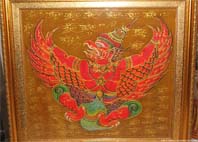Phya Kruith (Garuda) art work
"Emblem of Power and Fortune. Powerful blessing"
"DHL delivery"
Garuda is the Royal Emblem in Thailand, symbol of monarch. There was story of Garuda visit the King Rama 5th bed room and played chess and dice game with the King. This story passed down for generation. Garuda blessing great fortune and protect those who hold it.
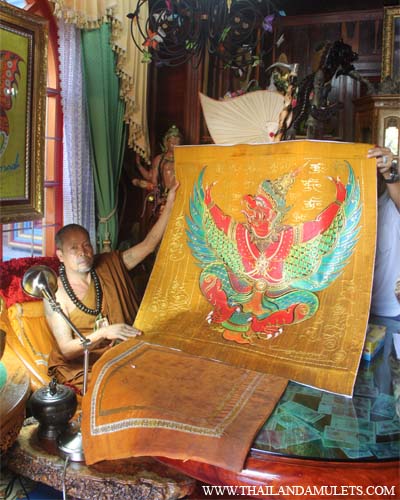
Emblem of Power and Fortune, great prosperity and powerful protection. Kruba Krissana is one top guru monk who can created finest piece of holy item with great art on it, one and only. The handmade Garuda blessing, is one best holy items guru monk ever made by Kruba Krissana Intawanno.
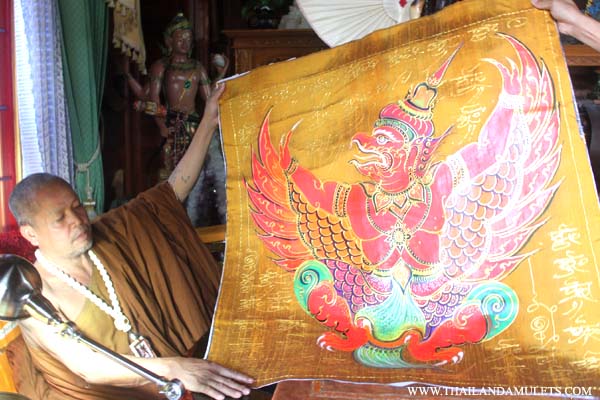
Special handmade, holy art work by Kruba Krissana Intawanno. Consecrate 3 full days at Kruba's temple. Powerful painting, blessing great fortune.
In Thai mythology, Garuda is known as the king of birds. With characteristics very much like and eagle, Garuda in the act of tearing Naga in two, symbolizes the Thai monarchy. It is an ancient and enduring symbol. Besides serving as the royal insignia, the Garuda is also the official seal of the civil government.
The emblem has varied in design from one reign to the next. The Garuda appears in all forms of artr, architecture and even modern sculpture. Some old paintings have been found depicting Narai or Vishnu mounted on Garuda, with Naga in his talons, or in flight.
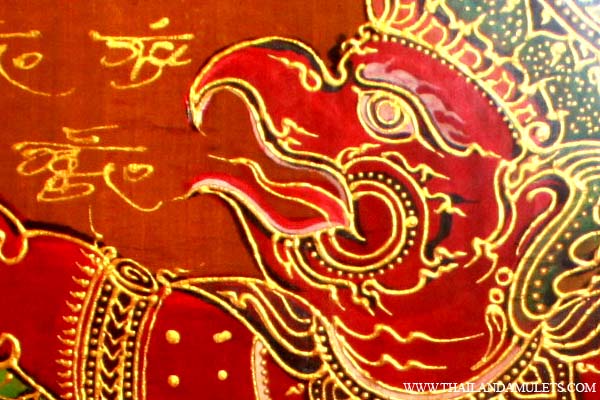
This mythic eagle and symbol of sovereignty was inspired by Hindu mythology. Hinduism portrays Garuda as a powerful deity in the lower domains of heaven, who sometimes comes among human beings. In the story of Kaki, Garuda came down from his celestial residence to gamble with the king in a dice game. In this wellknown story, Garuda saw the beautiful Kaki and stole her away.
According to Hindu mythologies, Garuda was a powerful celestial being. At his birth, there appeared a radiance so brilliant that all heaven was trobled. Thinking that the new arrival was Agni, the Fire God, the heavenly hosts came to pay homage.
Garuda is typically shown with the bill and wings of bird, but the body and limbs of a man, as well. His face is white, the mouth red, the body green.
The influence of ancient Brahmanism is still felt in royal ceremonies which pay homage to Garuda. The various ancient kingdoms in Southeast Asia, including Thailand, have been touched by Indian culture as far back as the 12th and 13th centuries of the Buddhist Era. The supreme deities in the Hindu pantheon are Shiva, Vishnu and Brahma. There are a host of lesser spiritual divinities, of which Garuda is one. His likeness is depicted in the sculpture, architecture and painting adorning Hindu and Brahman temples. Garuda is also found in royal Buddhist temples, in accordance with the Hindu belief that the king is an incarnation of Narai, who comes to alleviate human suffering. Garuda is the vehicle of Narai, and has been a symbol of the monarchy for hundreds of years.
Garuda appears regularly in the history of Thai art. Bronze Garuda adorn royal sedan-chair and embellish the thron. Sometimes the figure decorates the gables and rooftops of royal residences. The frequent appearance of the symbol certainly reflects the belief in the Devaraja of divine king. The sovereign is revered as a divine epiphany, and incarnation of Vishnu who comes into the world, bringing peace and end to suffering.
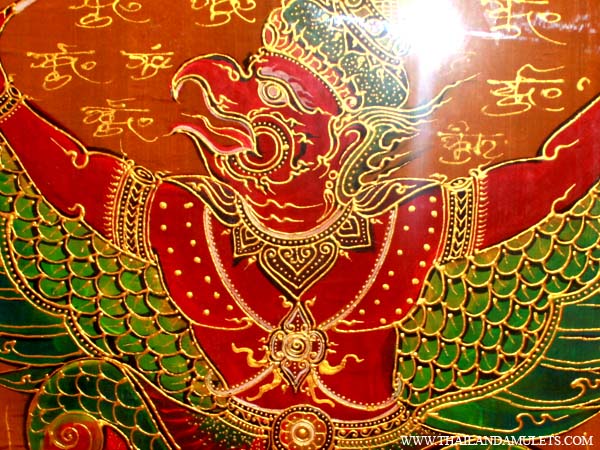
Depositions of Garuda vary, in part, according to the fantasies and visions of the artists in different eras. In the Dvaravati art of 1200 to 1400 B.E., Garuda is a winged creature with a plump, male body. Much later, in the LopBuri art of 1500 to 1799 B.E., Garuda becomes a powerful bird, like an eagle, king of the sky. The artist saw the deity as half-bird, haft-man. The face was human, but with a long, hooked beak, and the figure had both arms and wings. The lower part was like a bird. Images like this appear in the Ayutthaya and Rattanakosin Periods.
The most familiar image of Garuda shows him holding a serpent in each taloned hand. The origins of this image lie in an ancient story. According o one interpretation, Garuda is really powerful because of the blessing his father, Kasyapa, granted to his mother, Vinata. She asked that her son have power over all the gods. Garuda has a brother, Aruna, who has only the upper paert of his body. It happened because Vinata, in her excitement and anxiety to see her son, broke open the egg too soon. Angry with his mother, Aruna cursed her. She would be Naga's slave until her younger son, Garuda, could purchase his mother's freedom by bringing Naga some heavenly ambrosia.
Garuda was able to carry off the ambrosia, even though it was heavily guarded. It was told that Garuda overcame many heavenly beings indeed in order to gain the ambrosia. No one was able to get the better of him, not even Narai. At last, a truce was called and an agreement was made to settle the rancor and smooth all the ruffled feathers. If was agreed that when Narai is in his heavenly palace, Garuda will be positioned in a superior status, atop the pillar above Narai's residence. However, whenever Narai wants to travel anywhere, Garuda must serve as his transport. This legend is expressed in court protocal. When the King is in residence, the maharaja flag with the Garuda insignia is raised above the royal apartments. When his Majesty travels, however, the flag flies from the front of the royal vehicle. That is, Narai is seated above Garuda.
Some say that Garuda is as powerful as the Fire God, or that Garuda represents the Sun God. It is also notable that Garuda is the symbol, in philosophy, of Wisdom.
Click here for more about Garuda
Powerful blessing, fortune multiply forever
The best of Thailand Buddha Statues/Amulets at
www.thailandamulets.com / www.thailandamulet.com



